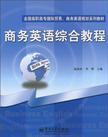商务英语综合教程
2010-8
电子工业出版社
赵淑容,李辉 主编
247
随着全球经济一体化的快速发展,国际贸易和商务活动日益频繁。21世纪社会对商务英语人才的需求已呈多元化趋势,如何培养应用型商务英语人才成为目前高校亟待解决的问题。根据市场对商务英语专业人才需求的具体要求,既具有扎实的英语基础、又拥有一定的国际贸易专业知识和实践技能的综合性“实用”人才是有很大市场需求的,排在所有专业的前五位,其中既懂经贸理论知识又懂外语的专业人才需求形势明显走俏。尽管世界金融危机对全球影响很大,中国经济也面临着前所未有的考验,但我国外贸行业在面临巨大挑战的同时也会有巨大的机遇。因此,对商务英语人才的需求量还是比较大的。我国目前的商务英语教材虽然很多,但真正适合高职高专学生应用的很少。高职商务英语专业如何顺应市场的变化,构建专业的优势,为社会培养熟悉涉外商务岗位群的知识和技能,具有动手+动口优势和较强就业竞争力的实用型人才已经是迫在眉睫。编者根据多年的教学实践,按照“实际、实用、实践”的原则,编写一本使高职学生现在“必须够用”和将来发展“迁移可用”的教材。 本书编者对课程体系、教学内容和教学方法进行了较大改革。根据新的课程体系和教学内容,编者们决定编写一部商务英语专业的基础专业课教材。经过多次召开会议,讨论教材编写大纲和遴选教材编写人员。教材脱稿后,又组织专家评审,最后定稿。现在,这本教材终于要出版了。 1.基本原则 我们确定的基本原则是:坚持学科体系的系统性和完整性,处理好现代内容与经典理论之间的关系,及时反映学科前沿动态和发展趋势;坚持理论与实践相结合,在系统阐述本学科的基本理论和基础知识的基础上,注重运用这些理论和知识去解释和研究现实问题;坚持理论体系的逻辑性和教学活动的渐进性,合理安排教学内容,以充分体现教材建设的先进性、思想性、科学性和实践性。 2.本套教材编写的指导思想及目标 为了编写这套教材,我们反复学习了教育部高等学校商务英语教学大纲,访问了毕业生用人单位,举行了商务英语毕业生座谈会,广泛地听取了师生的意见。
本书主要内容包括企业简介(Company profile)、商务会议(Business meeting)、商务谈判(Business negotiation)、商务合同(Business contract)、运输(Transport)、保险(Insurance)、付款方式(Methods of payment)、出口单证(Export documentation)、争端解决(Dispute settlement)、世界贸易组织(Wodd trade organization)、市场营销(Marketing)、电子商务(E-commerce)、财务与结算(Finance&settlement)、服务产业(Service industry),附录(Appendix)介绍世界500强企业。 本书可作为高职高专商务英语专业、国际贸易专业二年级学生商务英语专业课程教材,也可以为广大从事商务、外贸的人士扩充商务英语方面的知识以及为广大学生报考及通过各种商务英语等级证书提供帮助。
Unit 1 Company profileUnit 2 Business meetingUnit 3 Business negotiationUnit 4 Business contractUnit 5 TransportUnit 6 InsuranceUnit 7 Methods of paymentUnit 8 Export documentationUnit 9 Dispute settlementUnit 10 World tmde organizationUnit 11 MarketingUnit 12 E-commerceUnit 13 Finance&settlementUnit 14 Sewice industriesAppendix The World Top 500 Companies参考文献
There are many different ways to segment negotiation to gain a greater understanding of theessential parts. One view of negotiation involves three basic elements: process, behavior andsubstance. The process refers to how the parties negotiate: the context of the negotiations, theparties to the negotiations, the tactics used by the parties, and the sequence and stages in which allof these play out. Behavior refers to the relationships among these parties, the communicationbetween them and the styles they adopt. The substance refers to what the parties negotiate over: theagenda, the issues (positions and——-more helpfully——interests), the options, and the agreement(s)reached at the end. Another view of negotiation comprises 4 elements: strategy, process and tools, and tactics.Strategy comprises the top level goals——typically including relationship and the final outcome.Processes and tools include the steps that will be followed and the roles taken in both preparing forand negotiating with the other parties. Tactics include more detailed statements and actions andresponses to others statements and actions. Some add to this persuasion and influence, assertingthat these have become integral to modem day negotiation success, and so should not be omitted. Negotiating strategy Skilled negotiators may use a variety of tactics ranging from negotiation hypnosis, to a straightforward presentation of demands or setting of preconditions to more deceptive approaches such ascherry picking. Intimidation and salami tactics may also play a part in swaying the outcome ofnegotiations. Another negotiation tactic is bad guy/good guy. Bad guy/good guy tactic is when onenegotiator acts as a bad guy by using anger and threats. The other negotiator acts as a good guy bybeing considerate and understanding. The good guy blames the bad guy for all the difficulties whiletrying to get concessions and agreement from the opponent.
